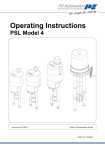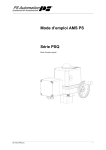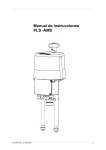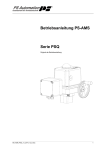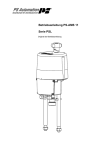Download Operating Instructions AMS1x PSL Model 4
Transcript
Operating Instructions AMS1x PSL Model 4 Version 07/12/2012 ©2012 PS Automation GmbH Subject to changes without notice! 1 2 Contents 1. Symbols and safety .............................................................................................................................. 4 2. Usage as per specification ................................................................................................................... 5 3. Storage ................................................................................................................................................. 5 4. Operating conditions ........................................................................................................................... 5 4.1 Installation position ....................................................................................................................... 6 5. Function ............................................................................................................................................... 6 6. Manual operation ................................................................................................................................ 7 7. Valve mounting .................................................................................................................................... 8 7.1 PSL-AMS202-214............................................................................................................................ 8 7.2 PSL-AMS320-325.......................................................................................................................... 10 8. Electric supply .................................................................................................................................... 11 8.1 Safety ........................................................................................................................................... 11 8.2 Wiring diagram ............................................................................................................................ 12 8.3 Mains supply ................................................................................................................................ 12 8.4 Interfaces ..................................................................................................................................... 13 8.4.1 Communication Interface ..................................................................................................... 13 8.4.2 Input Terminals ..................................................................................................................... 13 8.4.2.1 Galvanically isolated Set-Value .......................................................................................... 13 8.4.2.2 Sensor Feedback for Process Controller (optional) ........................................................... 13 8.4.2.3 Galvanically Isolated Binary Input ..................................................................................... 14 8.4.2.4 Fail-safe port for Binary Input (optional) ........................................................................... 14 8.4.3 Output Terminals .................................................................................................................. 14 8.4.3.1 Active Position Feedback ................................................................................................... 14 8.4.3.2 Additional Position Switches (optional)............................................................................. 14 8.4.3.3 Voltage feed to Process Sensor (optional) ........................................................................ 15 8.4.3.4 Fault Indicating Relay (optional) ................................................................................... 15 8.4.3.5 Fieldbus Interface (optional) ............................................................................................. 15 8.5 Accessories................................................................................................................................... 15 8.5.1 Space Heater (optional) ............................................................................................................ 15 8.5.3 Adjusting Additional Position Switches (optional)................................................................ 16 9. Status display/ Operating element .................................................................................................... 16 10. Operation ......................................................................................................................................... 17 10.1 Cut-off in End Positions ............................................................................................................. 17 10.1.1 Cut-Off by Force / Torque ................................................................................................... 17 10.1.2 Cut-Off by Position automatically ....................................................................................... 17 10.1.3 Cut-Off by Position.............................................................................................................. 17 11. Commissioning................................................................................................................................. 17 11.1 Automatic commissioning ......................................................................................................... 18 11.2 Manual commisioning ............................................................................................................... 18 12. Status messages ............................................................................................................................... 19 12.1 Fault indicator relay ................................................................................................................... 19 12.2 Tracing faults.............................................................................................................................. 19 13. Maintenance and repair .................................................................................................................. 19 14. Safety on transportation.................................................................................................................. 19 15. CE – Declaration of Conformity ....................................................................................................... 19 16. Tracing faults.................................................................................................................................... 20 3 1. Symbols and safety General dangers of non-compliance with safety regulations PSL actuators are built at state-of the art technology and are safe to operate. Despite of this, the actuators may be hazardous if operated by personnel that has not been sufficiently trained or at least instructed, and if the actuators are handled improperly, or not used as per specification. This may • cause danger to life and limb of the user or a third party, • damage the actuator and other property belonging to the owner, • reduce safety and function of the actuator. To prevent such problems, please ensure that these operating instructions and the chapter on "Safety" in particular have been read and understood by all personnel involved in the installation, commissioning, operation, maintenance and repair of the actuators. Basic safety notes • The actuators may only be operated by skilled and authorized operating personnel. • Make sure to follow all security advices mentioned in this manual, any national rules for accident prevention, as well as the owner´s instructions for work, operation and safety. • The isolating procedures specified in these Operating Instructions must be followed for all work pertaining to the installation, commissioning, operation, change of operating conditions and modes, maintenance, inspection, repair and installation of accessories • Before opening the actuator cover, ensure that mains supply is isolated and prevented from unintended reconnection. • Areas that can be under voltage have to be isolated before working on them. • Ensure that the actuators are always operated in faultless condition. Any damage or faults, and changes in the operational characteristics that may affect safety, must be reported at once. Danger signs The following danger signs are used in this operating manual: Caution! There is a general risk of damage related to health and/or properties. Danger! Electrical voltages are present that may lead to death. Life threatening risks may occur due to electrical voltages! Danger! This sign warns of hazards posing a risk to health. Ignoring these instructions can lead to injuries. 4 Other notes • The motor surface temperature may rise when maintaining, inspecting and repairing the actuator immediately after the operation. There is a danger of burning the skin! • Always consult the relevant operating instructions when mounting PS-S accessories or operating the actuator with PS accessories. • Connections for signal in- and output are double isolated from circuits that can be under dangerous voltage. 2. Usage as per specification • PSL linear actuators are exclusively designed to be used as electric valve actuators. They are meant to be mounted on valves in order to run their motors. • Any other use is considered to be non-compliant and the manufacturer cannot be held liable for any damage resulting from it. • The actuators can only be used within the limits laid out in the data sheets, catalogues and other documents. Otherwise, the manufacturer cannot be held liable for any resulting damage. • Usage as per specification includes the observance of the operating, service and maintenance conditions laid down by the manufacturer. • Not to be regarded as usage as per specification are mounting and adjusting the actuator as well as servicing. Special precautions have to be taken while doing this! • The actuators may only be used, serviced and repaired by personnel that is familiar with them and informed about potential hazards. The specific regulations for the prevention of accidents have to be observed. • Damages caused by unauthorized modifications carried out on the actuators are excluded from the manufacturer's liability. • Supply voltage may only be switched on after the proper closure of the main cover or terminal box. • Electrical wiring is done to a terminal block under the actuator cover. 3. Storage For appropriate storage, the following instructions have to be met: • Only store the actuators in ventilated, dry rooms. • Store the actuators on shelves, wooden boards, etc., to protect them from floor moisture. • Cover the actuators with plastic foil to protect them from dust and dirt. • Protect the actuators against mechanical damage. 4. Operating conditions • Standard actuators may be operated at ambient temperatures from -20°C to +60°C. • Operating modes correspond to DIN EN 60034-1: S2 for short cycle and S4 for standard operation (for actuator specific data see the actuator specific data sheets). • For protection against moisture and dust, the enclosure rating is IP65 or IP67 according to EN 60529. • When installing the actuators, leave enough space to allow cover removal (Fig.1). • The actuator can be installed vertically or horizontally or any position in between. The actuator must not be installed with the cover pointing downwards (Fig.2). 5 PSL-AMS320325 PSL-AMS208214 (Stroke 50) PSL-AMS208214 (Stroke 65) PSL-AMS202204 Figure 1: Installation dimensions 4.1 Installation position Outdoor usage: When using the actuators in environments with high temperature fluctuations or high humidity, we recommend using a heating resistor as well as a higher enclosure rating (optional accessories). Figure 2: Installation positions 5. Function The PSL-AMS actuators are designed as electric valve actuators. The valve is mounted onto the actuator via pedestals. Depending on the type of valve used, mounting pedestals or a special valve mounting plate is required. Mechanical power is created by a 24 volts DC-motor which is controlled from the electronics via pulse width modulation (PWM). The motor torque is transmitted via a multi-step spur gear to a trapezoidal thread spindle. 6 The spindle itself converts the induced torque into an axial force via a spindle nut. The spindle nut‘s resulting linear vertical motion is self-locking and is transmitted via a coupling piece to the valve stem. During power failure and adjustment work the actuators can be emergency-operated via the hand wheel (see chapter 5/Manual Operation), except when using the fail-safe unit PSCP. 6. Manual operation A handwheel is supplied in order to operate the actuator in case of power loss or during installation work such as mounting onto a valve or setting the limit positions. Do not exceed the adjusted electrical stroke limits by handwheel. The mechanical limits must be set accordingly. If these instructions are not observed, it may result in malfunction or damage to the actuator. Do not operate the handwheel using excessive force. If these instructions are not observed, it may result in malfunction or damage to the actuator. • The handwheel is permanently engaged and turns during motor operation of the device series PSLAMS1x202-214. • The actuators PSL-AMS1x320 - 325 have a handwheel which has to be engaged for manual operation. The ball-headed button on the cover has to be depressed to engage the handwheel. Figure 3: Manual operation *PSL-AMS208-214 Stroke 65m: Please remove the handwheel cover 7 7. Valve mounting 7.1 PSL-AMS202-214 Note: The pictures below show the mounting of a PSL204. The steps are identical for all types. When mounting the actuator onto the valve, use the handwheel and do not drive the actuator electrically. If these instructions are not observed, it may result in personal injury or damage to the actuator and/or valve. Coupling Coupling nut Pillar Clamping screws for spring pack Valve stem Locking nut Bracket Pillar nut 8 ① ③ ② 8 Nm Make sure that the coupling nut can be turned by hand ④ Drive coupling completely upwards by hand Put actuator onto valve. ⑤ Pillar end Bracket Bracket Pillar nut Appr. 5 mm Leave 5 mm gap between bracket and pillar nut ⑥ Appro. 5 mm Move the coupling down until it hits the valve stem. Continue moving until there is a 5 mm gap between the pillar end and the bracket. ⑦ 12 mm (M8, M12) / 16 mm (> M14) ⑤ + ⑥ Screw the coupling nut onto the valve stem until the pillar edges rest on the bracket. ⑧ Lock the coupling nut. Repeat ⑤ and ⑥ until the valve stem is screwed into the coupling nut by 12 mm (M8 to M12) resp. 16 mm (M14 and larger). ⑨ 8 Nm Tighten the clamping screws crosswise with 8 Nm. 9 ⑩ or Drive the coupling up or down, until the edges of the pillars rest on the bracket. WRONG CORRECT ⑪ Tighten the pillar nuts. Before the fastening nuts are tightened, make sure that the pedestal ends are completely inserted into the bores of the valve mounting plate. If necessary, correct the position of the actuator by using the handwheel. If these instructions are not observed, it may result in personal injury or damage to the actuator and/or valve. 7.2 PSL-AMS320-325 When mounting an actuator onto a valve, never drive the actuator electrically but use the handwheel. If these instructions are not observed, it may result in personal injury or damage to the actuator and/or valve. 1 2 3 4 5 6 7 8 9 10 11 Figure 4: Mounting the actuator onto the valve 10 = = = = = = = = = = = stroke scale spindle nut with locking device safety pin coupling piece valve mounting plate fastening nut valve body valve spindle swivel nut disc springs mounting pedestals The valve must be suitably equipped to take the mounting pedestals. Please see the individual dimension sheets for the actuator dimensions. Observe the following steps when mounting the actuator: • Unscrew the swivel nut (item 9) from the spindle nut (item 2) and slide it over the valve spindle (item 8). • See if the bore of the coupling piece fits the valve spindle. If necessary, rebore and/or recut the thread. • Slide or screw the coupling piece (item 4) onto the valve spindle and bore or pin to the valve spindle (disc springs, see chapter 8.2). • Slide the valve spindle with the coupling piece and disc springs (item 10) into the spindle nut, screw on the swivel nut and tighten it down using the cross slotted key supplied. • Slide the actuating pedestals (item 11) into the bore holes of the valve mounting plate and tighten with the fastening nuts. Before the fastening nuts are tightened, make sure that the pedestal ends are completely inserted into the bores of the valve mounting plate. If necessary, correct the position of the actuator using the handwheel. If these instructions are not observed, it may result in damage to the actuator and/or valve. 8. Electric supply 8.1 Safety Safety note When performing electric work on this unit, the local accident prevention regulations must be followed. Observe EN 60204-1 (VDE 0113 part 1) to ensure human safety, integrity of the assets as well as the proper functioning of the unit. Electric supply lines must be dimensioned for the peak current of the unit and comply with IEC 227 and IEC 245. See relevant data sheet. Yellow-and-green coded cords may only be used for connection to protective earth. When leading wires through the cable glands on the actuator, their minimum bending radius has to be considered. The electric actuators PSL-AMS are not fitted with an internal electric isolator, hence a switching device or circuit breaker must be integrated in the facility. It should be installed close to the actuator and should be easy to access for the user. It is important to mark the circuit breaker as this actuator‘s isolator. Electric installations and over-current protection devices must conform to the standard IEC 364-4-41, protective class I. 11 8.2 Wiring diagram Electric terminals are provided in a terminal box at the actuator. 8.3 Mains supply Isolate the power supply. Safeguard the line against unauthorized and unintended restarting. Open the terminal box. The terminal box provides terminals to accommodate rigid and flexible cables of wire widths of 0.14 mm² to 2.5 mm² as well as a PE screw on the housing. Caution: Please observe the supply voltage and the maximum power consumption of the actuator as indicated on the actuator‘s tag plate! Connect supply and control lines to terminals (as indicated in the wiring diagram). 12 8.4 Interfaces The actuator PS-AMS has several interfaces inside the terminal box which can be configured by the parameterising software PSCS or by the control box PSC (see relevant manuals). 8.4.1 Communication Interface For communication and parameterisation with a PC or a handheld device, connect the communication cable to the RJ45connector (item 4). Actuator parameters can be set using the software PSCS or the control box PSC (see relevant manuals). 8.4.2 Input Terminals 8.4.2.1 Galvanically isolated Set-Value 1 2 3 Terminals 1 through 3 are used to receive a parameterisable modulating set-value for control operation within the range of 020 mA or 0-10V. 8.4.2.2 Sensor Feedback for Process Controller (optional) 15 16 17 Terminals 15 through 17 are used to receive a process sensor‘s feedback to the - optional - process controller, in the parameterisable range of 0-20 mA or 0-10 V. Caution! The following binary inputs (8.4.2.3 und 8.4.2.4) have priority over the modulating set-value. If the actuator is parameterised for modulating service, these set-value settings are disregarded in the case a binary signal is applied. Only after disconnection of the binary signal the actuator will reposition according to the set-value applied. 13 8.4.2.3 Galvanically Isolated Binary Input 9 10 11 Terminals 9 through 11 are for binary open/close signals. Standard voltage level is 24 V, option is for 115/230 V; see wiring plan. The actuator is then driven in 3-point service. 8.4.2.4 Fail-safe port for Binary Input (optional) The fail-safe port (terminals 12 and 13) allows driving the actuator to a parameterized safety position by applying a voltage of 24 V. 12 13 8.4.3 Output Terminals 8.4.3.1 Active Position Feedback Terminals 4 through 6 are giving active position feedback, parameterisable within the range of 0-20mA or 0-10V. 4 5 6 8.4.3.2 Additional Position Switches (optional) 18 19 20 21 14 The activation points of the optionally available position switches are freely adjustable via cams. Terminals 18/19 and 20/21 provide potential-free opening or closing contacts. The standard switches are rated to 230VAC/5A. Special switches with gold plated contacts are available for low power (up to 100 mA and 30V). 8.4.3.3 Voltage feed to Process Sensor (optional) 14 Terminals 14 and 17 provide an unregulated output voltage of 24 to 30 VAC at maximum 100 mA to feed an external process sensor. 17 8.4.3.4 Fault Indicating Relay (optional) 7 8 This potential-free normally-open relay contact (terminals 7 and 8) allows displaying parameterisable fault indication to the control room. 8.4.3.5 Fieldbus Interface (optional) Optionally a fieldbus interface can be fitted to the AMS-actuator, with wiring to a terminal block or an external socket. -> See special operating manual for AMS-Fieldbus. 8.5 Accessories 8.5.1 Space Heater (optional) Actuators PSL-AMS can be fitted with a space heater. When using actuators in environments with high temperature fluctuations or high humidity, we suggest a heating resistor be fitted to prevent the build-up of condensation within the enclosure. In actuators PS-AMS the space heater is powered via the power supply of the actuator, so it does not have to be fed separately. For retro-fitting the heating resistor, wiring of the two cables has to be made to the terminals on the main board as per the picture on the left. 15 Mounting of the space heater has to be made to the indicated place on the base plate by using the screws provided. Route the cables in a way to prevent them from being squashed by the main cover, and from being touched by moving parts inside the actuator. 8.5.3 Adjusting Additional Position Switches (optional) In PSL-AMS two switches for position feedback are available as factory-mounted option. They are either normally-closed or normally-open contacts, potential-free. They are available with silver contacts (for currents between 10 mA and 5 A at maximum 230 V) or with gold-plated contacts (for currents between 0,1 mA and 30 mA at maximum 30 V). Connection goes to terminals 18/19 and 20/21. The cams for closing the switches are located on the switch plate, and are adjustable with a small screwdriver. Cam 1 is for retracting the spindle nut, while cam 2 is for extending the spindle nut out of the actuator. The potentiometer must not be adjusted. Non-observance may cause damage to the actuator! 9. Status display/ Operating element A red and a green LED on top of each other inside the terminal box indicate the status of the actuator. Another single red LED (optional) signals the status of the optional fieldbus interface. -> See special operating manual for AMSFieldbus. The commissioning button for starting the automatic commissioning run (to adjust the actuator to the valve) is located inside the terminal box, below the communication port. 16 10. Operation All internal parameters, like required motor torque, actual position, functional status, etc., are being permanently monitored during operation of the actuator PS-AMS. This ensures that the actuator positions with optimum accuracy, and closes the valve always tight. Deviations can be read out via communication software PSCS or via local control PSC.2 (see respective instruction manuals), or can be displayed to the control room using the optional fault indication relay. This provides maximum safety of the process. 10.1 Cut-off in End Positions Cut-offs of the PS-AMS actuators can be adjusted to meet the valve function in an optimum way by using the communication software PSCS (using a special interface cable, or optionally Bluetooth connection). This will result in different behavior of the actuator. In case a position is surpassed or not reached, this can be read out via the optional Fault Indication Relay or via the communication software PSCS. 10.1.1 Cut-Off by Force / Torque Der Antrieb bringt bei jedem Anfahren der Endlage das eingestellte maximale Drehmoment auf. Wenn sich der Anschlag in der Armatur verschiebt, zum Beispiel durch Verschleiß einer Sitzdichtung, dann führt der Antrieb im Rahmen seines möglichen Verfahrwegs den Schließpunkt nach. 10.1.2 Cut-Off by Position automatically In normal operation, the actuator will stop at the position which was found at a mechanical stop in the valve or the actuator during Automatic Commissioning. If the closing point inside the valve dislocates, the actuator will NOT follow this dislocation but it will always stop at the point initially found. 10.1.3 Cut-Off by Position In normal operation, the actuator will stop at the point which was defined by Manual Commissioning. This position is not depending on any mechanical stop inside valve or actuator. 11. Commissioning The actuator is shipped in the „not commissioned“condition with the green LED flashing slowly. There will be no response to any input (set value or open/close signal). To make the actuator operational, it has to be commissioned to a valve. Depending on the type of cut-offs programmed (see 10.1) there are two ways to do commissioning: - Automatic commissioning is done if at least one of the cut-offs is set to be “by force/torque” or “by position automatically”. - Manual commissioning has to be made in case both cut-offs are “by position”, either via software PSCS or via control box PSC.2. 17 Caution! Electrical operation of the actuator is allowed only after mounting to a valve! 11.1 Automatic commissioning (Only available if at least one of the cut-offs is set to be “by force/torque” or “by position automatically”. ① ② Press the commissioning button for 3 sec Commissioning in progress (Grenn LED is flashing, actuator drives in both positions) ③ Green LED lights – Actuator successfully commissioned and ready tob e used 11.2 Manual commisioning ① Connect your PSCS-USB cable with your PC and start the software PSCS 18 ② ③ Select actuator type and interface in the software Select Operate -> Commissioning and confirm the dialog wiht OK ④ Adjust the 0-Point and check it with „send“; Save with OK ⑤ Green LED lights – Actuator successfully commissioned and ready to be used Note If the parameterised valve stroke, starting from the adjusted closed position, exceeds the possible actuator stroke, then the operating stroke will be reduced to the resulting maximum possible value. 12. Status messages 12.1 Fault indicator relay Fault messages can be transmitted to the control room with a maximum load of 24 VDC/100 mA via an optionally available closing contact at terminals 7 and 8. The messages can be parameterised via software PSCS or control box PSC. -> See relevant manuals 12.2 Tracing faults See the table on page 20 for explanation of the blinking codes of the status-LEDs. 13. Maintenance and repair Under the conditions of use as per specification as lined out in the data sheet, the PS-AMS actuators are free of maintenance. All gears are lubricated for their service life and do not require to be re-lubricated. Clean the actuators with a dry soft cloth and do not use any cleaning agent. Do not use any coarse or abrasive materials. 14. Safety on transportation For transportation and storage all cable glands and connection flanges have to be closed to prevent ingress of moisture and dirt. A suitable method of packaging is required for transporting to avoid damage of coating and any external parts of the actuator. 15. CE – Declaration of Conformity See page 23. 19 16. Tracing faults Red LED Green LED off Flashing slowly Flashing quickly Glowing permanently off Flashing slowly Flashing quickly Glowing permanently x x Status Probable reasons Possible remedy Actuator does not respond, both LEDs are off 1) No supply voltage applied 2) The applied voltage does not match the actuator voltage on the tag plate 1) Actuator not correctly commissioned 2) Too small stroke programmed (in mode “one positiondependent cutoff”) 1) Actuator not correctly commissioned 2) Actuator closing force/ torque too low 1) Fixed digital set-value is activated 2) Actuator is configured to work with process controller A non-linear valve curve has been parameterised Probable reasons 1) Check mains supply 2) Apply correct supply voltage x x Actuator does not drive the full stroke x x Actuator does not close the valve properly x x Actuator is in normal operating condition, but does not respond to setvalue changes x x Actuator position does not correspond to set-value input x x Operating conditions x x 20 1) Repeat commissioning 2) Check actuator selection 1) Check set-value parameters -> see instrucions AMS-PSCS 2) Connect process sensor Verify parameterised characteristic -> see instructions AMS-PSCS Possible remedy Normal operating condition X x x 1) Repeat commissioning 2) Check valve stroke parameters -> see instructions AMS-PSCS Actuator in commissioning mode x x X Actuator not commissioned Faults within the actuator’s environment Probable reasons Too high torque has been encountered within the valve stroke 1) Actuator not correctly commissioned to the valve 2) Mechanical block within the stroke path 3) Improper selection of the actuator 1) Process feedback wrongly or not at all connected 2) Process feedback outside od adjusted range 1) No proper process feedback (only in combination with PSIC) 2+3) Maximum control range exceeds (only in combination with PSIC) Commissioning mode will be left automatically after completion Depending on the type of cut-offs, the actuator has to be commissioned either automatically or manually Possible remedy 1) Repeat commissioning 2) Check valve and actuator for unobstructed running 3) Check actuator selection 1) Apply the correct process feedback signal and check polarity 2) Ensure the correct process feedback range 3) Check the process sensor and its supply voltage Red LED Green LED x x x off Flashing slowly Flashing quickly Glowing permanently Off Flashing slowly Flashing quickly Glowing permanently x Actuator drives into a preset position x x x Stored end position could not be reached Stored end position ment has been passed over Actuator supply voltage too low X x Set-value disconnected or outside the parameterized range x Faults within the actuator x x x x x Actuator has reached lifetime limit X Faulty electronics or invalid parameters x Critical or maximum temperature reached x Mechanical fault in the actuator 3) No process sensor signal available 1) Signal is applied to the binary failsafe input 2) Supply voltage failure on actuators with optional PSEP 1) Set-value not connected 2) Wrong polarity of set-value 3) set-value signal outside parameter range, please check Loose or dirty valve seat Valve seat worn or defective 1) Improper wiring of the mains supply 2) Jitter in supply voltage 3) Too low supply voltage from PSEP (with optional PSEP) Probable reasons Wear and/ or running time 1) Supply voltage interrupted during commissioning 2) Defective electronic component 1) Too high numbers of starts 2) Ambient temperature too high Defective mechanical part 1) Disconnect the signal 2) Check supply voltage 1) Apply set-value 2) Check the set-value polarity 3) Check the set-value range Check the valve seat Check the valve seat 1) Check mains wiring 2) Check supply voltage -> see datasheet 3) Contact PS service team Possible remedy Contact PS service team 1) Reload parameters (-> see manual AMSPSCS), then repeat commissioning 2) Contact PS service team 1) Check application and its adjustment 2) Check ambient temperature and try to reduce it -> see relevant data sheet Contact PS service team 21 22 Declaration of Conformity We, PS Automation GmbH Philipp-Krämer-Ring 13 D-67098 Bad Dürkheim Germany declare under our sole responsibility that we are manufacturing the electrical actuators of series PSL...; PSQ...; PSR...; PSL-AMS...; PSQ-AMS... according to the follwing EEC regulations: 89/336/EEC Electro-magnetical Compatibility 73/23/EEC Low Voltage Directive and that we have successfully tested them as per the following harmonized standards: EN 61000-6-2: 2001 Electro-magnetical compatibility (EMC), Generic standards Immunity for industrial environments EN 61000-6-4: 2001 Electro-magnetical compatibility (EMC), Generic standards Emission standard for industrial environments EN 61010-1: 1995 Safety Requirements for Electrical Equipment for Measurement, Control and Laboratory Use Bad Dürkheim, 2004 Max Schmidhuber (General Manager) CAUTION! To ensure compliance of these actuators with the above directives, it is the responsibility of the specifier, purchaser, installer and user to observe the relevant specifications and limitations when taking the product into service. Details are available on request, and are mentioned in the Installation and Maintenance Instructions. 23 Grossbritannien IMTEX Controls Ltd. Unit 5A, Valley Industries, Hadlow Road GB-Tonbridge, Kent TN11 0AH Tel.: <+44> (0) 17 32-85 03 60 Fax: <+44> (0) 17 32-85 21 33 eMail: [email protected] www.imtex-controls.com Hong Kong PS-MAXONIC Hong Kong Ltd. Room 803-4, Yale Industrial Centre 61-63 Au Pui Wan Street Fotan, Shatin, Hong Kong Tel.: <+852> 26 87-50 00 Fax: <+852> 81 01-37 43 eMail: [email protected] www.maxonicauto.com Italien PS Automazione S.r.l. Via Pennella, 94 I-38057 Pergine Valsugana (TN) Tel.: <+39> 04 61-53 43 67 Fax: <+39> 04 61-50 48 62 eMail: [email protected] China SHENZHEN MAXONIC AUTOMATION Control Co Ltd. 7th Floor, Block 7, Tian An Industrial Estate Nanyou, Shenzhen, Guangdong P. R. CHINA Tel.: <+86> 7 55 26 52 18 78 Fax: <+86> 7 55 26 05 28 00 eMail: [email protected] www.maxonicauto.com Schweiz Avintos Flow Control AG Weidenweg 17 CH-4310 Rheinfelden Tel.: <+41>61-83 61-5 30 Fax: <+41>61-83 61-5 99 eMail: [email protected] www.avintos.com Spanien Sertemo, S.L. Pol. Ind. Alba - Avda. Generalitat 15 Apartado de Correos, 142 E-43480 Vila-Seca (Tarragona) Tel. : <+34> 9 77 39 11 09 Fax : <+34> 9 77 39 44 80 eMail : [email protected] www.sertemo.com PS Automation GmbH 24 Gesellschaft für Antriebstechnik Philipp-Krämer-Ring 13 D-67098 Bad Dürkheim Tel.: +49 (0) 63 22 - 60 03 – 0 Fax: +49 (0) 63 22 - 60 03 – 20 eMail: [email protected] www.ps-automation.com Indien PS Automation India Pvt Ltd. Srv. No. 25/1, Narhe Industrial Area, A.P. Narhegaon, Tal. Haveli, Dist. IND-411041 Pune Tel. : <+ 91> 20 25 47 39 66 Fax : <+ 91> 20 25 47 39 66 eMail : [email protected] www.ps-automation.in
























